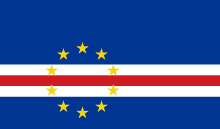Media of Cape Verde
| Part of a series on the |
| Culture of Cape Verde |
|---|
 |
| History |
| People |
| Languages |
| Cuisine |
| Religion |
| Literature |
|
Music and performing arts |
|
Media |
| Sport |
|
Monuments |
|
This article is about the Media in Cape Verde including its telecommunications, television and radio.
Telecommunications
In 2003, Cape Verde had 71,700 main line telephones with an additional 53,300 cellular phones in use throughout the country. In 2011, Cape Verde had 72,764 main line telephones with an additional 500,000 mobile and cellular phones in use throughout the country, cellular phones was nearly one per person.
In 2004, there were seven radio stations; six independent and one state owned. The media is operated by the Capeverdean News Agency (secondarily as Inforpress).
Television and radio
In 2002, there were about 100,000 radios and 15,000 television sets nationwide. Broadcasts are in Portuguese and Crioulo.
There were also three television stations; one state owned (RTC - TCV)[1] and three foreign owned, RTI Cabo Verde launched by the Portuguese-based RTI in 2005, on March 31, 2007, Record Cabo Verde, its own version was launched by the Brazilian-based Rede Record.[2] and TIVER. Cape Verde has now received TV CPLP and some of its programs are broadcast, the network first aired in 2016. Premium channels includes the Capeverdean versions of Boom TV and Zap Cabo Verde, two channels owned by Brazil's Record.[3] Other premium channels are aired in Cape Verde especially on satellite networks, they are common in hotels and villas but availability is predominantly limited, one of them is RDP África, the African version of the Portuguese radio station RDP.
Nationwide radio stations include RCV, RCV+, Radio Kriola, the religious station Radio Nova.[1] Local radio stations include Rádio Praia, the first radio station in Cape Verde, Praia FM,[1] the first FM station in the nation, Rádio Voz de Ponta d'Água of North Praia and Radio Morabeza in Mindelo.
Radio stations formerly existed included and Rádio Clube do Mindelo which later became Rádio Barlavento which existed until 1975, it was later replaced with Rádio Voz de São Vicente and became part of RCV.
Internet
There were approximately 20,400 Internet subscribers nationwide in 2003.
Internet providers and search providers in Cape Verde include SAPO CV and recently Google.

The only daily newspaper in 2005 was Horizonte (circulation figures unavailable). The government-run Novo Jornal-Cabo Verde (2002 circulation 5,000) is published twice per week. Weekly periodicals include A Semana,[1] Expresso das Ilhas,[1] Jornal Horizonte, Terra Nova, Boletim Informativo , A Nação, founded in 2007 and A Voz founded in 2013. Today, many of these national level newspaper sites are also available online (some with subscription). Regional newspapers includes Jornal O Cidadão (São Vicente), Artiletra (São Vicente), a bi-monthly newspaper/periodical, Jornal de São Nicolau and Oceanpress (Sal). Newspapers are written in the official language, Portuguese. Some such as A Semana and Jornal Horizonte has some articles written in Cape Verdean Creole. Newspapers, especially online are also written in English, some newsstands offers English language papers and rarely French especially at touristic areas of the islands of Sal and Boa Vista. The first English language papers were first written in the late-19th century but were rarely common, most of them were available in Mindelo, São VIcente which were one of the most coal refueling stopovers in West Africa. Online, recently some articles on A Semana is also available in English.
There are also online national level newspapers and news sources, sports-oriented news sources available includes Criolosport and recently Sports Mídia.
Others including the airline magazine of TACV Fragata.
History
In the colonial area, there was a journal that was like a newspaper, the first was Boletim Oficial de Cabo Verde (Official Bulletin of Cape Verde) which first published on 24 August 1842 on the island of Boa Vista. Second came Independente on 1 October 1877 in Praia, Santiago, third came O Correio de Cabo Verde (Cape Verde Post) on 19 April 1879 and fourth came Echo de Cabo Verde (Echo of Cape Verde, Modern Portuguese: Eco de Cabo Verde) first published in April 1880. Mindelo made journals included Revista de Cabo Verde and Liberdade, both started in 1889.
In Praia, there were journals including O Povo Praiense, first made on 13 July 1886, O Praiense made in 1889 and later Praia made in the same year.
One of the recent was named Notícias de Cabo Verde (News from Cape Verde) and Jornal de Cabo Verde (Cape Verde Journal) during the mid 20th century, started publishing in 1931 and the newer O Eco de Cabo Verde (Echo of Cape Verde).
Freedom of speech
The Constitution of Cape Verde provides for free expression, and the government is said to uphold this right generally. Government authorization is not needed to establish newspapers, other printed publications, or electronic media.
Online newspapers abroad
One media based abroad is VozDiPovo-Online, an online newspaper founded in 2004 and is based in Aveiro, Portugal and serves the Capeverdean community there.
See also
References
- 1 2 3 4 5 "Cape Verde Profile: Media". BBC News. Retrieved 12 June 2017.
- ↑ "Record se destaca em Cabo Verde". A Semana. April 2008. Retrieved 25 November 2010.
- ↑ "TV Record Cabo Verde disponível também nos canais a cabo em Cabo Verde". ZAP TV and BOOM TV. Archived from the original on 2016-02-04.
Bibliography
- "Cape Verde: Directory". Africa South of the Sahara 2004. Regional Surveys of the World. Europa Publications. 2004. p. 195. ISBN 1857431839. (Includes information about newspapers, radio, etc.)
- "Cape Verde", Freedom of the Press, USA: Freedom House, 2015, OCLC 57509361
- Fernando Cristóvão (Hrsg.): Dicionário Temático da Lusofonia. Texto Editores, Lissabon/Luanda/Praia/Maputo 2006 ISBN 972-47-2935-4, p. 541
- João Nobre de Oliveira: A Imprensa Cabo-Verdiana 1820–1975, Fundação Macau, Macau 1998 ISBN 978-972-65-8017-1
External links
- Karen Fung, African Studies Association (ed.). "News (by country): Cape Verde". Africa South of the Sahara. USA – via Stanford University.
Annotated directory